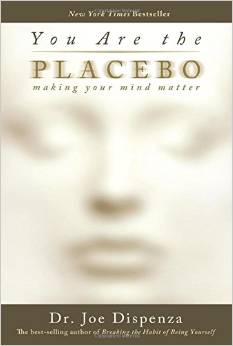PROFOUND AUDIO: You are the Placebo: Making Your Mind Matter
You are the Placebo: Making Your Mind Matter.
The audio link below links to Dr Joe Dispenza's research on neuroplasticity. He shares easy-to-understand and encouraging explanations how one can re-wire the brain and re-condition the bodies to make lasting changes. This is a PROFOUND reminder of the power that is in each of us.
Step into the river of change
Going from the old self to the new self, that void between the two, is the biological, the neurological, the chemical and even the genetic death of the old self.
Head over to this LINK and drop down to the second interview - put down distractions and LISTEN intently. The other interviews are great as well.
Excerpt: The concept of epigenetics is fascinating. We’re not our genes. There’s not gene for leadership or a gene for alcoholism or a gene for homosexuality. Genes are turned on and off based on the state outside of the cell. So when the person has a new experience, or making a new connection or string of connections in the brain, in order for those nerve cells to connect, there has to be genetic components that begin to activate it.
When I talk about rewriting the gene or beginning to change the cell, from a theoretical standpoint what the cell is doing is its receiving new information, and the cell is actually taking that information and beginning to make new protein. Protein is an expression of life, and proteins are responsible for the function and structure of your body. So when you begin to change your thoughts, you begin to change your behaviors, etc., there are genes that are activated. Some of those genes are actually passed on to the next generation. We’re talking about programming the genes or programming the cell. The cell may look biologically the same, it may have the same receptor sites. But really what’s happening is that the cell is expressing itself differently. What is the past? For a cell the past is same gene turned on and the other gene turned off.
Add this NEW SUPERFOOD for Weight Loss, Glowing Skin, and Overall Health
Groundbreaking new research has revealed the importance of the microbiome, the vast community of bacteria that lives within us. It turns out these bacteria outnumber our cells by a factor of 10 to 1!
Believe it or not, we are more bacteria than we are human. The microbiome in our gut governs many of our body’s key functions and is crucial to our overall health. A balanced microbiome regulates the immune system, metabolism, sustains the gastrointestinal tract, supports mood and brain function, produces crucial vitamins and nutrients, and helps us maintain a healthy weight.
Dr. Kellman has written extensively about the microbiome and its contribution to our health in his new book, The Microbiome Diet. Enjoy this guest post - and his great perspective on "old wisdom" in our fast paced life by incorporating new SUPER FOODS into your day!
So if you want to lose weight and feel better it’s essential that you balance the microbiome in your gut. One of the most effective ways to do that is by eating fermented foods. Fermented foods are rich in live bacteria that replenish the microbiome, helping it maintain the right proportion of friendly bacteria for optimal health and weight loss. I call fermented foods part of the new generation of Superfoods.
These Superfoods help our bodies absorb nutrients and keep our microbiome balanced. An unbalanced microbiome causes gut distress, so even if we take all the vitamins, minerals, and antioxidants in the world we won’t really improve our health.
So on the Microbiome Diet I include the next generation of superfoods: the foods, spices, and supplements that help heal our gut and balance our microbiome. Chief among them are fermented foods, which are the next frontier in prepared foods. In fact, fermented foods might even become the new American cuisine.
Fermented Foods: Natural Probiotics
Probiotics are pills, powders, or capsules that contain billions of live bacteria, which help replenish your microbiome. Fermented foods are a type of natural probiotic, because they contain so many live bacteria along with many other crucial nutrients.
Every culture in the world has its own fermented foods, which is a strong indication of how crucial they are to our health. The chart below offers a brief sampling of fermented foods around the world.
COUNTRY |
FOODS |
|---|---|
Caucasus |
koumiss, a fermented milk drink |
China |
douchi, a fermented black bean sauce |
China, Middle East |
kombucha, a fizzy, fermented tea |
Russia |
kvass, a fizzy beer-like drink made from black or rye bread |
Ethiopia/Eritrea |
injera, a spongy bread made from fermented teff flour |
Ghana |
fufu, a fermented product made from cassava, yams, or plantains |
Himalayas |
bhatti jaanr, fermented rice food-beveragegundruk, a fermented leafy vegetablekodo ko-jaanr, a fermented millet productsinki, a fermented radish |
India |
dhokla, a steamed food made from fermented rice and chickpeasdhosa, a dish of fermented rice and lentils |
Japan |
miso, fermented soybean paste, used in soups and saucesnatto, fermented soybean caketempeh, steamed and mashed fermented soybeans |
Mexico |
pulque, fermented alcoholic beverage made from cactus juice |
Nigeria |
garri, a fermented product made from cassava |
Russia |
kvass, a fizzy fermented beer made from black bread or rye bread |
South Pacific |
poi, fermented taro paste |
Thailand |
pla ra, fermented fish sauce |
You can find fermented foods in many forms: pastes, seasonings, condiments,
curries, stews, pickles, and even candy. They can be fried or boiled or sometimes candied, and they can be eaten in main dishes, side dishes, salads, or desserts.
Fermented drinks also take many forms. They can be alcoholic, such as beer and wine, or nonalcoholic, such as certain teas, vinegar-based drinks, or buttermilk.
The universal consumption of fermented foods is the strongest possible demonstration of how much we humans need this type of food in our diets. Sadly, the growing prevalence of Western fast foods and packaged foods is wiping out traditional food cultures, which I have come to believe is one of the primary causes of the worldwide obesity epidemic.
Fortunately, as health consciousness grows, interest in fermented foods has grown as well. The following foods are healthy fermented foods that are readily available in the United States and can be easily incorporated into a Western diet:
• Sauerkraut—a version of fermented cabbage eaten throughout Eastern Europe, Russia, Austria, and Germany
• Kimchee—a Korean version of fermented cabbage, carrots, onions, and garlic
• Fermented vegetables—available ready-made in most stores and online
• Kefir—a fermented milk drink from the north Caucasus
• Yogurt—another type of fermented milk product eaten throughout central and west Asia, India, central Europe, and the Balkans
All of these foods are frequently found in the meal plans and recipes in The Microbiome Diet. I highly recommend them, both for weight loss and for overall improvement of numerous symptoms, including depression, anxiety, brain fog, skin problems, hormonal issues, immune weaknesses, digestive problems, and fatigue. A healthy microbiome can transform our endocrine, immune, digestive, and nervous systems—and by supporting the microbiome, fermented foods support these aspects of the body as well.
Sauerkraut
The name “sauerkraut” literally means sour cabbage. The cabbage is pickled by a process known as lacto-fermentation,in which glucose and other sugars in the cabbage are converted into energy and lactic acid. Various types of bacteria—including lactobacilli, leuconostoc, and pediococci—enable the fermentation. These bacteria are also crucial in promoting balance within the microbiome.
A number of companies make organic sauerkraut. One that I recommend to many patients is Bubbies (www.bubbies.com), which makes a number of high-quality fermented and picked products, including an excellent sauerkraut and some wonderful pickled green tomatoes.
Both the sauerkraut and the tomatoes are natural probiotics—sources of live bacteria. The tomatoes are also a naturalprebiotic—sources of the dietary fiber on which friendly bacteria feast. Tomatoes are full of a prebiotic known asarabinogalactans, which are extremely nourishing to helpful bacteria and thereby promote microbial balance.
Tomatoes are also rich in lycopene, a prime antioxidant, and in vitamin C, another antioxidant. They have plenty of vitamin A, which helps to heal the gut. They also offer have terrific cardioprotective benefits through lowering cholesterol and triglycerides and reducine platelet stickiness. They are also good for bone health.
For a more exotic sauerkraut, a company called Wildbrine (www.wildbrine.com) offers a red beet and sauerkraut salad, a curried cauliflower and sauerkraut salad, and a ginger sauerkraut salad, as well as a more traditional dilled sauerkraut.
Kimchee
Koreans find kimchee so delicious that they eat some with virtually every meal. We Americans could do far worse than to imitate their example, since kimchee is one of the healthiest probiotic foods there is, with proven support for weight loss as well.
A 2011 study published in the journal Nutrition Researchfound that fermented kimchee had a significant impact on the weight and body fat of the overweight and obese patients who were being studied. Not only did the patients shed both weight and fat, they also showed improvements in blood sugar, blood pressure, and the waist-hip ratio—an important biomarker of metabolic health.
Kimchee has also been shown to lower cholesterol, prevent constipation, and combat colon cancer. In addition, it can help to reduce stress, relieve depression, combat osteoarthritis, reduce atherosclerosis, and fighting liver disease.
Sunja’s (www.sunjaskimchi.com) offers a wonderful line of fermented vegetables prepared kimchi-style. In addition to the traditional kimchi-style cabbage, you can find fermented kale, radish, cucumber, and beets. There is also a “white kimchi” that offers the health benefits of fermentation without the spiciness of traditional kimchi.
Like pickled and fermented tomatoes, fermented radishes offer a double benefit: the fermentation offers a naturalprobiotics; the radishes are a natural prebiotic. Radishes are also high in magnesium and manganese (crucial for the production of digestive enzymes), vitamin C (a terrific antioxidant and immune system support), calcium (for bone health), folate, and vitamin B6 (good for coping with stress and supporting brain function). In addition, radishes offer some ability to combat inflammation, an immune system response that promotes weight gain.
Wildbrine also offers two variations on traditional kimchi—a Japanese-style miso and horseradish kimchi and a Thai-flavored kimchi prepared with lemongrass, mint, red curry, and pineapple—as well as a traditional Korean version.
Fermented Vegetables
As we have seen, fermented vegetables are natural probiotics, and many are also natural prebiotics. In addition to the fermented vegetables offered by Sunja’s, you can find excellent choices from Bao Fermented Food and Drink, which offers a fermented cabbage that it markets as “Raw Slaw,” as well as a fermented hot sauce and—one of my favorites—a fermented ketchup. Unlike most traditional  ketchups, which are loaded with sugar and other problematic ingredients, Bao’s raw, sour, and fermented ketchup offers plenty of tangy flavor but no added sugar, gluten, or preservatives.
ketchups, which are loaded with sugar and other problematic ingredients, Bao’s raw, sour, and fermented ketchup offers plenty of tangy flavor but no added sugar, gluten, or preservatives.
Bao also makes kombucha, a fermented tea and a refreshing natural probiotic drink. Bao’s kombucha comes in seven flavors: original, berry, ginger, grape, mango, spice, and super green.
Kefir
Kefir—a fermented milk drink that resembles a liquid yogurt—is yet another natural probiotic. In addition to promoting microbial balance, it offers incredible support for your immune system and has traditionally been used to treat tuberculosis and cancer.
Sadly, many types of commercially available kefir are sold with fruit and other flavorings mixed in. This destroys the live bacteria and also adds many grams of sugar to the product, making it counterproductive as a weight-loss food and problematic for health generally. Kefir needs to be plain and unflavored to retain its full health benefits, although serving it with fresh fruit is fine.
Goat’s milk kefir has also become commercially available. This is fortunate, because many people are sensitive to cow’s milk but can tolerate from sheep’s and goat’s- milk products. Goat’s milk kefir—if unflavored and packaged without fruit—allows many more people to benefit from kefir without risking the inflammatory challenges that might be produced by the cow’s milk.
Yogurt
Like kefir, yogurt has numerous health benefits—but only when it is packaged plain, unflavored, and without fruit, although serving it with fresh fruit is fine. The health benefits of yogurt are numerous, as are its weight-loss benefits. In June 2011, the New England Journal of Medicine reported on research linking yogurt consumption with improved weight.
The article reported on “Intriguing evidence [which] suggests that changes in colonic bacteria might influence weight gain.” A year earlier the British Journal of Nutrition found
that the kinds of bacteria found in yogurt produced improvements in insulin sensitivity and inflammation.
Depression and the Brain Chemistry of Women (a path to more balance inside)
It's safe to say that every women has been effected by depression or anxiety in their lives. It has become more common for this to be a state of "being" as our lives continue to be interrupted by electronics, busy schedules, and the everyday stressors of work and family obligations. Sad but important to know - WOMEN are affected two to three times as often as men by most forms of depression and anxiety disorders and are four times more likely to suffer from symptoms of SAD or seasonal affective disorder.
 The gender difference is found at all ages after puberty. Millions of women today are diagnosed with depression and are being treated with antidepressant drugs such as Prozac, Paxil and Zoloft, known as SSRI’s, selective serotonin reuptake inhibitors.
The gender difference is found at all ages after puberty. Millions of women today are diagnosed with depression and are being treated with antidepressant drugs such as Prozac, Paxil and Zoloft, known as SSRI’s, selective serotonin reuptake inhibitors.
Many woman experience behavioral or emotional changes associated with phases of their menstrual cycles as well as during pregnancy, post pregnancy, perimenopause and menopause. This has led researchers to conclude that the higher depression prevalence in women is due mainly to the wild swings in hormonal releases along with their feedback mechanisms to the brain during the female life cycle. These hormonal swings affect the production and breakdown of the brain neurotransmitters serotonin, dopamine, and norepinepherine, which are associated with the quality of feelings and emotions.
Serotonin is the main depression-relieving brain chemical or neurotransmitter. Neurotransmitters are chemicals that transmit messages from nerve cell to nerve cell in the brain and between the brain and the organs of the body. Adequate brain levels of serotonin are directly associated with emotional stability, an inner sense of well-being, relaxation, and promote restful sleep. Low levels of serotonin lead to the many symptoms of depression, which include: chronic despair, feelings of regret, numbness, lack of passion and sex drive, chronic fatigue and excessive hunger.
One or more of the following could cause low levels of serotonin: a decrease in serotonin production related to estrogen fluctuations, insufficient levels of tryptophan crossing the blood brain barrier, or a depletion of serotonin storage levels. In general, the female body, partly due to lower muscle mass, produces and stores less serotonin than its male counterpart. This is one important reason why muscle-building exercise is a key component of female wellness. A regular diet and exercise routine, including a daily protein-based breakfast, has a direct effect on healthy serotonin production.
Most of our serotonin is produced in the early morning, when the first rays of sunshine stimulate the pineal gland and it converts the amino acid tryptophan into serotonin. Given these facts, it is vital for females to focus on starting each day with a balanced routine. During the hours of darkness, the pineal gland is stimulated to produce melatonin (the sleep hormone) from a hopefully adequate supply of serotonin. More than ever, “early to bed, early to rise”, “eat a healthy breakfast” and “get your exercise” are powerful suggestions for those seeking a balanced life.
Tryptophan is found in certain protein-based foods, including chicken, turkey, pheasant, beef, dairy, nuts, and legumes (beans). One of the richest legume sources of tryptophan comes from the protein found in the soybean. Having a nutritious shake made from whole-food fermented soy powder or a whey protein powder will provide the right type and amount of protein needed to produce an ample supply of serotonin.
Adding fruit or berries and a tablespoonful of flax seed oil to this nutritious shake will satisfy the body’s need for sugar in the form of complex carbohydrates and omega-3 fatty acids. Both of these are also needed for proper serotonin production. It is advisable to add a good quality vitamin B complex and vitamin C to ensure that the body has adequate levels for healthy nerve and neurotransmitter formation.
When the body is provided with the proper building blocks of nutrition, serotonin is produced and released by the brain. Some of this serotonin is used up and some of it is reabsorbed within the brain and then converted into other chemicals such as melatonin. Ongoing serotonin production will adequately maintain serotonin storage levels, if brain chemistry is balanced and the building blocks for serotonin are present.
Alternative therapies for depression
 Most women I talk with — even those who are on antidepressants — have questions about their options. In my experience, an integrative approach that draws upon the full range of potential treatment methods — including traditional psychiatry, pharmacological options in some cases, nonpharmacological options, and holistic approaches — offers better symptom resolution and long-term recovery than any one single effort. An integrative, functional health care practitioner or counselor will fully evaluate your history and physical, and coordinate your care to meet your individual needs. Here are some options to explore.
Most women I talk with — even those who are on antidepressants — have questions about their options. In my experience, an integrative approach that draws upon the full range of potential treatment methods — including traditional psychiatry, pharmacological options in some cases, nonpharmacological options, and holistic approaches — offers better symptom resolution and long-term recovery than any one single effort. An integrative, functional health care practitioner or counselor will fully evaluate your history and physical, and coordinate your care to meet your individual needs. Here are some options to explore.
-
Talk therapy / counseling
-
Body work methods: Craniosacral therapy (CST), osteopathic manipulative therapy (OMT), chiropractic, therapeutic massage
-
Acupuncture, auriculotherapy
-
Phytotherapy from the Western herbal compendium: St. John’s wort, passionflower, valerian; or from other ancient traditional paradigms, such as Oriental medicinal herbs
-
Ayurveda, aromatherapy
-
Targeted amino acid support: SAM-e , 5-hydroxytryptophan, GABA
-
Nutritional supplements: vitamins, minerals, omega-3 fatty acids
-
Full-spectrum light therapy
Before you go on an antidepressant
Contrary to what some of the marketing campaigns for antidepressants tell us, feeling good is not just about one single molecule in the brain. There are almost always several underpinnings to depression. From sunlight to snacking, our brain chemistry can be coaxed with our choices. There is so much you can do in your daily life to support more positive moods. Here are our suggestions for where to start.
-
Eat a low glycemic-load, Mediterranean-style diet with adequate protein and abundant plant foods.
-
Adopt a high-quality multivitamin/mineral regime, including omega-3’s (EPA and DHA).
-
Have your vitamin D level tested regularly and, depending on your levels and geographic region, expose your skin safely to the sun or supplement with vitamin D accordingly.
-
Go to bed by 10:00 pm and get at least 8 hours of sleep each night.
-
Exercise 4–6 times a week for 30–60 minutes, preferably outdoors.
-
Avoid alcohol and other recreational drugs, opting instead for drug-free relaxation methods such as transcendental meditation, yoga, or qi gong.
-
Consider talking to your practitioner about alternative therapies like those described in the section above.
Give yourself a lift — naturally - but know when to seek professional help. xo
Guest Post: RoseMarie Pierce, Holistic Pharmacist and Women to Women
When does Menopause and Perimenopause Start? (are these hormone myths sabotaging you?)
MYTH: I don’t have to worry about hormones until menopause. Meanwhile, I can do whatever I want to my body – drink like a fish, party like a rock star, skimp on sleep – without consequences.
TRUTH: This is one of those myths that even most doctors believe!
Many hormone levels – such as estrogen, progesterone, and testosterone – start to drift downward in your twenties. Other hormones, like cortisol, often spike too high and pull other hormones out of balance. Women younger than thirty may not yet feel affected by the aging process, but perhaps they want to get pregnant (or keep the option open) or avoid the wrinkles that they see on their mom’s face.
At What Age Do Menopause and Perimenopause Start?
 Menopause occurs at a mean age of 51. Perimenopause, the years from about 35 to 50, are famous for hormonal chaos, but even Chinese Medicine recognizes that subtle hormonal shifts begin at age 28.Quite poetically, Chinese Medicine teaches that your energetic meridians are focused on your pelvic region during your reproductive years, and as reach toward menopause, chi starts to flow more toward your heart. In the West, we’re far less poetic. We focus on how many ripe eggs are left in the ovaries at any given time,how’s the egg quality based on a lab test, and when am I finally going to meet the life partner so that I can get busy having babies. Here’s where you want to focus your energy:
Menopause occurs at a mean age of 51. Perimenopause, the years from about 35 to 50, are famous for hormonal chaos, but even Chinese Medicine recognizes that subtle hormonal shifts begin at age 28.Quite poetically, Chinese Medicine teaches that your energetic meridians are focused on your pelvic region during your reproductive years, and as reach toward menopause, chi starts to flow more toward your heart. In the West, we’re far less poetic. We focus on how many ripe eggs are left in the ovaries at any given time,how’s the egg quality based on a lab test, and when am I finally going to meet the life partner so that I can get busy having babies. Here’s where you want to focus your energy:
Women In Their 20s…
… benefit from understanding that the best way to mind your hormones so that you are brimming with vitality begins early. Master your sleep (94% of us need 8 hours each night), eat nutrient-dense food (and not too much), stop sitting so much, and detox your liver periodically (off the alcohol). When you don’t indulge stress and let it overpower you, you’re actually creating hormonal grace. The reason is simple: Cortisol, the main stress hormone, controls the levels of the other key hormones in your body, including thyroid, estrogen, progesterone, and testosterone.
Women in Their 30s…
… may feel increasingly tense and overwhelmed, in need of better strategies on how to chillax. Your goal should be to prevent the high blood pressure, prediabetes, and accelerated aging that come with chronically high perceived stress.
Women in Their 40s/50s…
… may want to regain the buoyancy of their earlier life. Perhaps you want to wake up feeling more restored, without the obsessive thoughts or brain fog.
Women 60+
 … may wish to optimize their cognitive functioning—to improve their thinking, memory, and competitive edge. Don’t suffer needlessly. I don’t want you to be misinformed by prevailing myths, underserved by your doctors, or miseducated by the media. With natural hormone balancing, these years can be fun and sexy. It starts with being fully informed about your hormonal status, regardless of age.
… may wish to optimize their cognitive functioning—to improve their thinking, memory, and competitive edge. Don’t suffer needlessly. I don’t want you to be misinformed by prevailing myths, underserved by your doctors, or miseducated by the media. With natural hormone balancing, these years can be fun and sexy. It starts with being fully informed about your hormonal status, regardless of age.
Guest Post: Sara Gottfried
Heal and Balance your Hormonal Beauty with these Delicious Sea Vegetable Recipes
These green wonders can strengthen bones, counteract obesity and provide the iodine we need for proper thyroid functioning.
Enjoy this great guest post and try these new and healthy recipes!
Sea vegetables are just what they sound like: greens that grow in the sea. These healthy vegetables include nori (what your sushi is wrapped in), wakame (what is in your miso soup), arame (often in your seaweed salad), dulse, kombu, kelp and hijiki. Sea vegetables also include varieties of seaweed hidden in prepared foods such as ice cream, baked goods, jelly, salad dressings, chocolate milk and  toothpaste.
toothpaste.
Grown in the depths of the sea, these green wonders are full of vitamins and minerals essential to human health and nutritional balance. Minerals make up seven to thirty-eight percent of the dry weight of these superfoods; the most significant minerals found in sea greens are calcium, iodine, phosphorous, sodium and iron, but they are also rich in other nutrients like protein and vitamins A, B, C and E.
Sea vegetables can help with everything from reducing blood cholesterol, removing metallic and radioactive elements from the body, and preventing goiters. Seaweed also has antibiotic properties, may counteract obesity, could improve digestion and nerve transmission, and strengthens bones and teeth. To top it off, sea veggies have been researched as a beauty aid for their skin-improving and anti-aging properties.
Sea vegetables and thyroid health
Seaweed got a boost of recognition earlier this year after the devastating earthquake in Japan, thanks to the presence of the mineral iodine in these vegetables. Radiation fears spread to the west coasts of Canada and the United States when the quake and subsequent tsunami caused serious damage to a nuclear reactor; iodine pills are given to protect against some of the effects of radiation.
Iodine is also a key mineral for thyroid health, which is the role it’s more likely to play in the average person’s diet. Our bodies need iodine for thyroid hormone production, which helps keep our metabolism working properly. That’s why weight gain is a symptom of hypothyroidism and weight loss is a symptom of hyperthyroidism — our metabolism, and therefore our weight, is affected when these hormones are out of whack.
People used to get their RDA of iodine — 150mcg for most adults — largely from iodized salt, but as more people reduce the sodium in their diets, deficiencies could occur. That’s one important reason why seaweed is a great dietary addition — it’s one of the best food sources of iodine. Regularly including a variety of sea vegetables in your diet can help keep your thyroid working properly.
How do you use sea veggies?
Sea vegetables are extremely versatile — they can be used in a number of recipes and incorporated into numerous styles of cuisine. They compliment or accent many dishes, from soups and salads to even desserts.
Here are some other recipes using sea vegetables that you can try:
Easy-roll sushi wraps Barley sushi salad with nori Nori-wrapped double-ginger chicken Raw goddess soup
Also, give sea vegetables a go in your diet with this recipe using seaweed in perhaps its most familiar form — as the wrapping for nori rolls.
Vegetarian nori rolls
Ingredients: 3 cups short-grain brown rice 4 ¼ cups water 3 pinches sea salt 1 avocado, skinned and sliced 3 scallions (green onions), green parts, blanched or raw 1 carrot, cut into long julienne strips, blanched or raw 1 cucumber, sliced into thin strips and marinated in salt and vinegar 1 mango, cut into thin strips 4-6 sheets of nori Wasabi powder mixed in water to form a paste Pickled ginger
Vinegar mixture: 2 ½ tablespoons brown rice vinegar 2 ½ tablespoons maple syrup 5 tablespoons mirin (a popular Japanese condiment) 1 teaspoon sea salt
Directions: 1. Cook rice with water and salt for 40-50 minutes. (three cups rice to four-and-a-half cups water)
2. When rice is finished cooking, spread on cookie sheet with wooden spoon paddle and cool by waving sushi mat back and forth or place in refrigerator.
3. In small pot, bring vinegar, maple syrup, mirin and salt to a boil; simmer until salt is dissolved and cool the liquid to room temperature. Sprinkle on cooled rice.
4. To assemble rolls; lay nori sheet flat on sushi mat. Press rice onto nori, leaving two inches of edge free of rice. Arrange vegetables along center of rice and roll pressing tight with mat.
5. Peel mat away and place sushi log on cutting board and slice evenly into six to eight pieces, starting from the centre.
Guest Post: Marni Wasserman is a culinary nutritionist in Toronto whose philosophy is stemmed around whole foods.
Youthful Fall HC Inspiration: Look & Feel Younger Instantly
A great haircut can make a woman look and feel ten years younger – instantly! A great haircut can hide wrinkles ("it ok"...we understand secret motives), add body and life, define the jawline, and enhance cheekbones.
All-time Classy Hairstyle
A classic hairstyle is soft and feminine, sophisticated, and timeless. A mid-length haircut for mature women is often best and age appropriate. Soft layers beautifully frame the face and add volume; the antidote to visually aged or thinning hair. Adding “bangs” may sound a little too scary – but done properly, they help cover age spots or wrinkles on the forehead that many women become sensitive to.
Variations of a medium length cut will compliment women differently. For youthful looking hair with bounce, one must start with healthy hair.
Coloring to Lighten and Brighten' Highlights can appropriately compliment your base color. Highlights (and lowlights!) are a key component to looking younger. I recommend having discussion with your stylist about the alternatives to dimension and placing highlights versus a solid color – when done wrong or with a conventional/home hair color job - you can pull the hair dark which is unflattering and harsh, especially against mature skin.
Low Cost - Big Impact
The best approach is to apply a "spot foil" of glowing blonde or bronze to bring brightness to your skin tone.
The next time you visit your hair salon, be prepared to step out looking younger, feeling younger, and absolutely loving your new style.
Contact our expert team today to lighten and brighten your hair color and style.
Do You Know How to Stay Clean in a Toxic World? LEARN HOW AT THE DETOX SUMMIT! (details inside)
As many of you know, our health and beauty company see's through a Functional Medicine lens. I’ve written about many times on my blog, the toxins of our environment, nutrition, beauty products, and more - is affecting our health in so many ways. This is especially important during pregnancy and early childhood.
The toxicity of our environment and how that is interacting with our genes. We call this the epigenetic influence. You can now learn about the latest research online through the DETOX SUMMIT!
It is free! Each day, a set of lectures will appear and you will have the whole day to listen to those lectures.
You can sign up for the Detox Summit here.
Do You Know How to Stay Clean in a Toxic World? LEARN HOW AT THE DETOX SUMMIT!
For example, I just finished this video where Soram Khalsa, MD shares great info on Women's Health & Toxicity. Here are a few important facts from his webinar:
-
There are over 85,000 known chemicals we interact in and 90% have never been tested for safety.
-
The average women uses 9 personal care products per day. Each product on average has 14 chemicals. This averages 126 chemicals per day that are known to disrupt our endocrine system.
-
Phthalates are a catalyst to an increase in Breast Cancer, inflammation, infertility, etc.



















